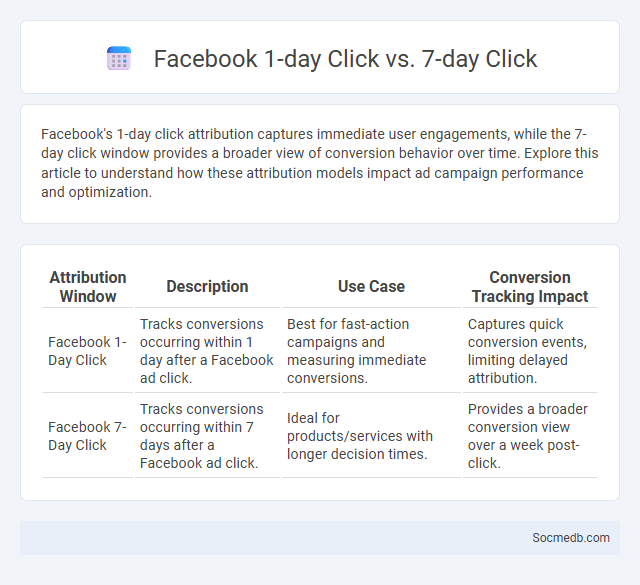
Photo illustration: Facebook 1-day Click vs 7-day Click
Facebook's 1-day click attribution captures immediate user engagements, while the 7-day click window provides a broader view of conversion behavior over time. Explore this article to understand how these attribution models impact ad campaign performance and optimization.
Table of Comparison
| Attribution Window | Description | Use Case | Conversion Tracking Impact |
|---|---|---|---|
| Facebook 1-Day Click | Tracks conversions occurring within 1 day after a Facebook ad click. | Best for fast-action campaigns and measuring immediate conversions. | Captures quick conversion events, limiting delayed attribution. |
| Facebook 7-Day Click | Tracks conversions occurring within 7 days after a Facebook ad click. | Ideal for products/services with longer decision times. | Provides a broader conversion view over a week post-click. |
Understanding Facebook Attribution Windows
Facebook attribution windows define the time frame in which a user's actions are credited to a specific ad after engagement, crucial for measuring ad performance accurately. Common attribution windows include 1-day click, 7-day click, 1-day view, and 7-day view, each capturing different user behaviors and conversion timelines. Optimizing campaigns requires analyzing these windows to determine how long after interaction conversions occur, enabling precise allocation of advertising budget and improved return on ad spend (ROAS).
What is 1-Day Click Attribution?
1-Day Click Attribution measures the impact of social media ads by tracking conversions that occur within 24 hours after a user clicks on an ad. This attribution model helps you understand the immediate effectiveness of your campaigns in driving user actions like purchases or sign-ups. By analyzing 1-Day Click Attribution data, you can optimize ad targeting and budget allocation to maximize short-term engagement and ROI.
What is 7-Day Click Attribution?
7-Day Click Attribution tracks the impact of your social media ads by crediting conversions that happen within seven days of a user clicking on an ad. This model helps you understand the direct influence of clicks in driving actions, providing clearer insight into your campaign's effectiveness. By using 7-Day Click Attribution, you can optimize your strategies to maximize returns on your advertising spend.
Defining the “Conversion” Metric on Facebook
The "Conversion" metric on Facebook measures specific user actions taken after interacting with an ad, such as purchases, sign-ups, or downloads, directly linked to campaign goals. This metric is tracked using the Facebook Pixel or Conversions API, enabling advertisers to attribute actions to ad performance accurately. Optimizing for conversions allows marketers to target audiences more effectively, improving return on ad spend (ROAS) and achieving measurable business outcomes.
Key Differences Between 1-Day Click and 7-Day Click
1-day click attribution captures user actions within 24 hours after an ad interaction, providing immediate performance insights primarily useful for fast-purchase decisions. 7-day click attribution tracks conversions up to seven days post-click, offering a broader view of user behavior and capturing delayed purchase decisions typical in high-consideration products. Marketers use 1-day click for campaigns aimed at quick conversions and 7-day click to evaluate overall campaign effectiveness and user engagement over time.
Impact on Ad Performance Measurement
Social media platforms provide extensive data analytics allowing advertisers to measure ad performance with precision through metrics like engagement rate, click-through rate, and conversion tracking. The integration of advanced algorithms and AI enhances the accuracy of attributing sales and user actions directly to specific ad campaigns. This real-time insight supports dynamic optimization, improving ROI and targeting strategies in digital marketing.
When to Use 1-Day Click vs 7-Day Click
Use 1-day click attribution for campaigns targeting impulse purchases or time-sensitive offers, as it captures immediate user actions accurately. Opt for 7-day click attribution when promoting products or services with longer decision-making cycles, allowing attribution to reflect delayed conversions. Selecting the right attribution window optimizes ad spend by aligning conversion tracking with typical customer behavior patterns.
Effects on Budget Optimization and ROI
Social media campaigns drastically influence budget optimization by enabling precise targeting and real-time performance tracking, which helps minimize ad spend wastage. You gain deeper insights into customer behavior and engagement metrics, allowing for data-driven adjustments that improve ROI. Leveraging platforms' advanced analytics tools maximizes marketing efficiency, ensuring every dollar spent contributes to measurable business growth.
Best Practices for Attribution Setting Selection
When selecting attribution settings for social media campaigns, prioritize models that align with your business objectives and customer journey, such as last-click, first-click, or data-driven attribution. Utilize platform-specific insights from Facebook, Google, or LinkedIn to accurately measure conversions and optimize ad spend based on user interactions. Understanding your attribution model empowers you to allocate budget efficiently and enhance campaign performance through data-backed decisions.
Final Thoughts: Choosing the Right Attribution Window
Choosing the right attribution window directly impacts your social media campaign's accuracy in measuring conversions and ROI. Your decision should align with your sales cycle length and user behavior patterns on platforms like Facebook, Instagram, or LinkedIn. Optimizing the attribution window ensures better budget allocation and deeper insights into your audience engagement.
 socmedb.com
socmedb.com